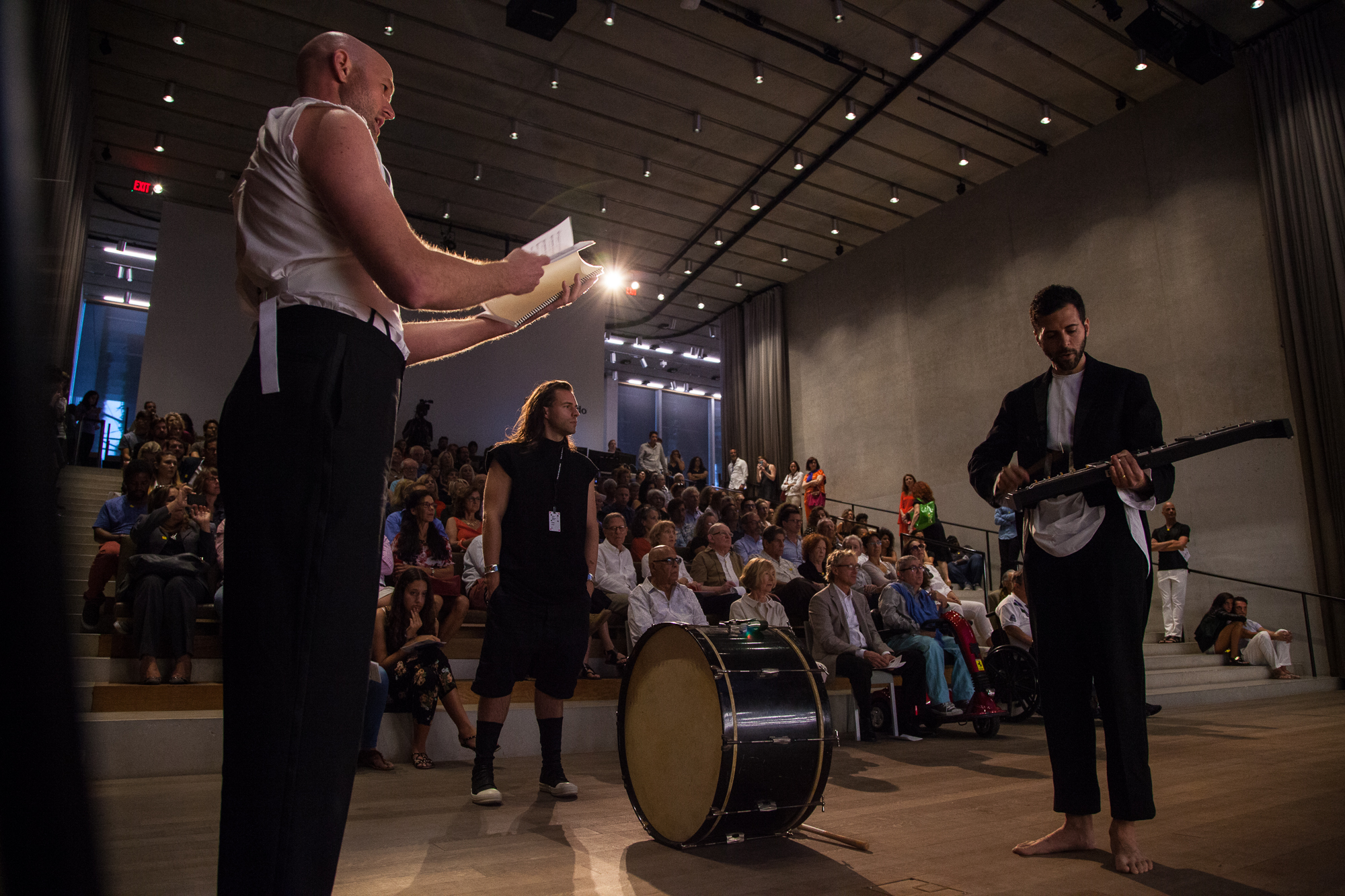
IlluminArts transforms and transfixes with experimental opera at PAMM
Above: Singer Zachary James, director R.B Schlather, musician Michael Weinfield-Zell. All photos by Francisco Javier Moraga Escalona.
The audience attending “the little match girl passion” sat on mats on the broad staircase or in the upper echelon seats in the elegant auditorium at the Perez Art Museum Miami. The two sections are divided by a stage in between, so where people chose to sit would determine how they watched–and experienced–this experimental opera.
And what an experience it was: conceptually smart, emotionally powerful–and witty, too.
It was a project from 2015 Knight Arts Challenge winner IlluminArts, which is a Miami-based group that aims to combine vocal chamber music with visual arts through a series of collaborative events in museums and galleries.
For this program, IlluminArts was inspired by the superb Colombian artist Doris Salcedo, whose exhibit is currently showing at PAMM. Rooted in the ubiquitous violence, loss and trauma of her homeland, her works have a dark but poetic beauty. Not unlike the tragic but lyrical 19th-century tale from Hans Christian Andersen, “The Little Match Girl,” where a starving girl dies of cold on a street in Denmark, ignored by those walking by her. In both there is some suggestion of ultimate hope, but it’s a hope that that seems far from the literal suffering.
IlluminArts Artistic Director Amanda Crider, also an opera singer, thought it would be fascinating to combine the 2008 Pulitzer Prize-winning composition “the little match girl passion” from David Lang with Salcedo’s exhibit.
That’s the backdrop to this performance, which held rehearsals open to the museum-going public leading up to the final June 2 presentation.

“The little match girl passion” at PAMM.
As people took seats on either of the two tiers, they were greeted by a mini concert performed by Michael Weinfield-Zell, playing various percussive instruments for the atonal “The Anvil Chorus” (also a Lang composition). Those who made it to the second deck started to realize something else a little off-kilter–they were being filmed in real-time walking up the stairs, which was projected on the large wall above the second stage.
Eventually four barefoot opera singers climbed the stairs, but sat not on that second stage but against a wall, next to an exit door. They started singing the mournful tale: on a snowy night, a bareheaded and barefoot girl was trying to sell match sticks, but all those who passed by her ignored the little shivering figure. As museum visitors continued to walk past the singers, unwittingly they mimicked the way people had bypassed the girl.
Those sitting on the stairs below, however, couldn’t see the projection, and therefore couldn’t also understand the occasional giggles as someone was caught on camera–like the little boy with a hat who kept running in and out of view.
It took most of the audience a little while to figure out what was going on, and how to engage with the performance, making everyone in a sense an interactive participant.
The entire combined visual and aural effect was mesmerizing.
Toward the end, the singers rose and slowly walked down to the bottom stage, and put on shoes waiting for them there; all except one pair. They exited the auditorium, and to end the short opera, musician Weinfield-Zell–who had continued to accompany the piece with his drum while moving through both decks–donned the last pair.
The connection to the Salcedo exhibit was pronounced with this final scene. In her series “Atrabiliarios,” which takes up one room in the exhibit, Salcedo has placed mostly shoes, in pairs, into the wall and covered each rectangular recessed installation with translucent animal skins. She said it is based on the countless number of women who have gone missing due to endless war and violence.
It was powerful stuff on all levels this evening at PAMM. If there was redemption waiting somewhere, on the surface it seemed hard to find–until you realized it came in the aesthetic and compositional beauty of both.
Crider was thrilled with the whole experience. “We didn’t know what the response would be, and were delightfully overwhelmed to see so many people in the audience,” she said.
She explained the sometimes disconcerting nature of the production. “The metaphor R. B. [Schlather, the acclaimed New York director] was speaking to in this production is that people often don’t know how to interact with classical music, and pass it by or don’t take time to consider it, just as people didn’t know how to interact with the little match girl, homeless out on the street trying to survive but ultimately dying while people passed by unaware. Our society has become absorbed with other things.”
In an unplanned but almost perfect ending, a woman had walked up the stairs and stood in full view of the camera, but unaware she was onscreen. “While they were singing, there was a girl caught onscreen taking a picture of herself with her phone, not taking notice of the tragedy underlined in the music….Her actions, however, seemed to highlight our statement with the piece.”
Overall, Crider said, the performers loved the experience. “I know that all of the performers were very moved by the Doris Salcedo exhibit, and felt the parallel between our presentation and her very important work. It’s exciting as performers to push the envelope and experiment with new ideas, and also to be given creative license to find our way through a piece in front of an audience, to see how they responded.
“There were some heightened emotions among the performers because of the technical and emotional difficulty of the piece, and also because of being on display for three hours a day. There were some tears shed. They all encouraged each other and became a beautifully cohesive team.”
Recent Content
-
Artsarticle ·
-
Artsarticle ·
-
Artsarticle ·
